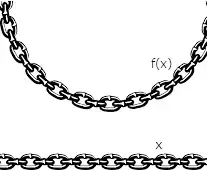I've been learning synthetic differential geometry, and while the infinitesimals and microlinearity axiom make sense to me, I have not been able to grasp the geometry of these infinitesimals. In smooth infinitesimal analysis and synthetic differential geometry, the ring $R$ replaces the real line, so we can imagine it as a line. In illustrations of the K-L Axiom, I have seen many pictures that look like this
that make the set of infinitesimals $D$ appear to be an "infinitesimal line segment". I got this idea not only from the illustrations from SIA/SDG that I've seen online, but in more formal textbooks that explain the infinitesimal world in similar geometric terms, like this:
As $D$ is not an ideal, $D(2) \not = D \times D$. We remark that $D(2)$ includes the axes $$ \{ (d,0) \ | \ d \in D \} \text{ and } \{ (0,d) \ | \ d \in D \} $$ but also the "diagonal" $$ \{ (d,d) \ | \ \in D \} $$ and indeed $$ \{ ( \alpha d, \beta b) \ | \ d \in D \} $$ for all $ \alpha, \beta $ of $R$.
Following this cue, I have tried to picture zooming in on a point in $R$ and coming to find another line of infinitesimals centered around it. I first encountered the issue with my visualization when I was trying to determine whether there is always some $k\in R$ (non-infinitesimal) such that $d_2 = kd_1$ for any pair $(d_1, d_2)\in D\times D$. Such a theorem would make sense of to me if $D$ can be conceptualized as a microscopic line. If this were the case then, $d_2\cdot d_2 = kd_1\cdot d_2 = 0$, and the invertibility of $k$ implies that $d_1d_2 = 0$. Hence, $D\times D = D(2)$, which I know is not true, as $D$ is not an ideal of $R$. This broke my picture, and I'm having trouble finding a new one.
Perhaps the fundamental issue with this picture of the "infinitesimal world" around a point is that it carries the notion of distance and an order. As I understand it, these are incompatible with the nature of infinitesimals as neither equal to zero nor distinct from it. It does not make sense to describe one infinitesimal as closer to zero than another.
Could I have some help on how best to conceptualize these new additions to the number line?


